Woodworkers, carpenters, hobbyists, and DIYers know the importance of an accurate angle.
Remember the age-old saying “measure twice, cut once”?
Just one or two degrees out on a single cut can sabotage an entire project and cost time and money for unwanted part replacements.
Mechanical angle finders or protractors can be tricky to use, especially for beginner woodworkers. This is where the digital angle finder comes into its own.
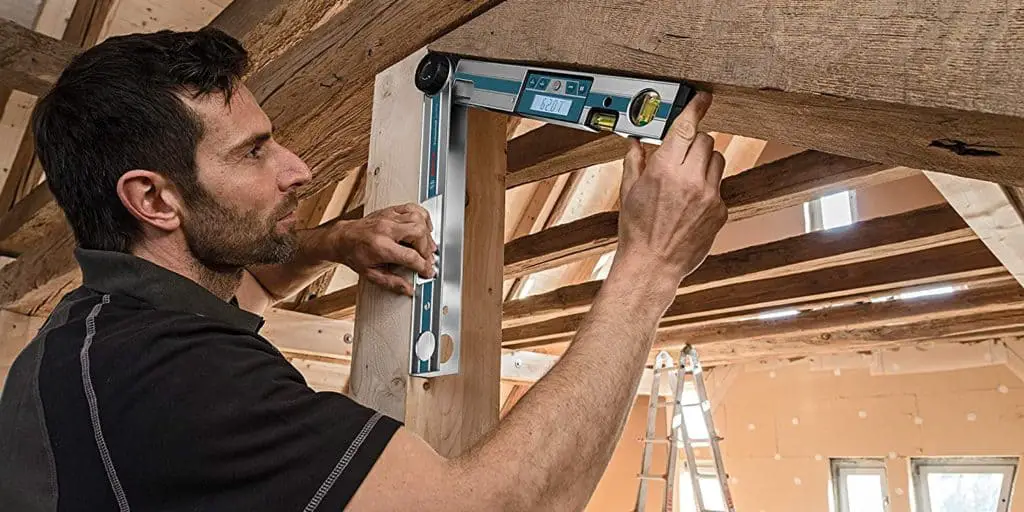
It is easy to use and offers close to 100% accuracy when it comes to angle measurement.
So, whether you are a beginner-level carpenter, a hobbyist, or even a professional in the field, a digital protractor angle gauge is one of those tools that is well worth the investment.
It can save you from making unnecessary errors and ensure the accuracy of your work.
The features that helped me select the Klein Tools Digital Electronic Level and Angle Gauge as my favorite overall, were outstanding value for money, versatility, and its wide range of applications.
But another digital angle finder (or protractor) might suit your needs betters, so let me show you some of the best options.
| Best digital angle finder / protractor gauge | Images |
| Best overall digital angle gauge: Klein Tools 935DAG | 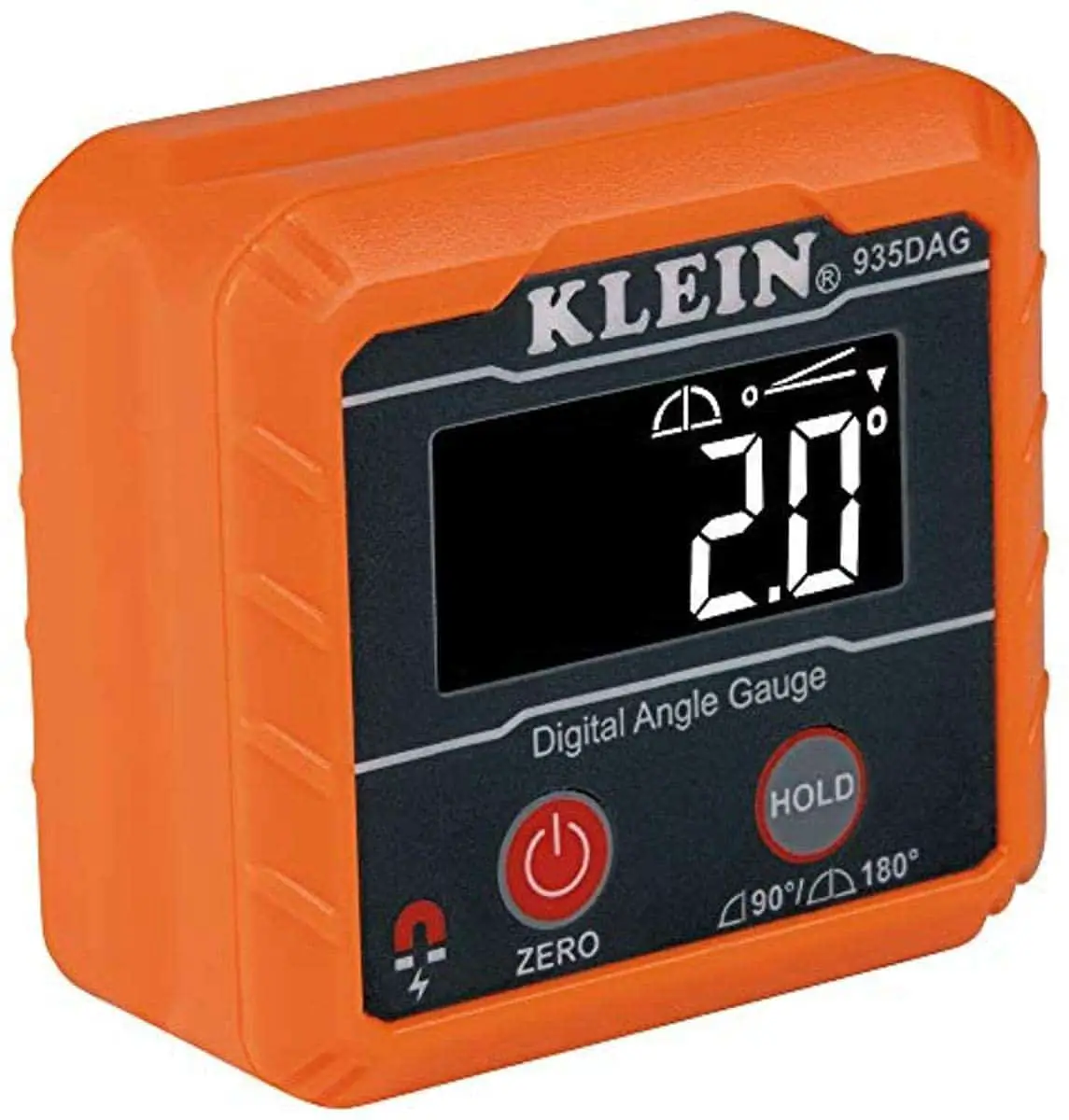 (view more images) |
| Best digital angle finder/protractor for professionals: Bosch 4-in-1 GAM 220 MF | 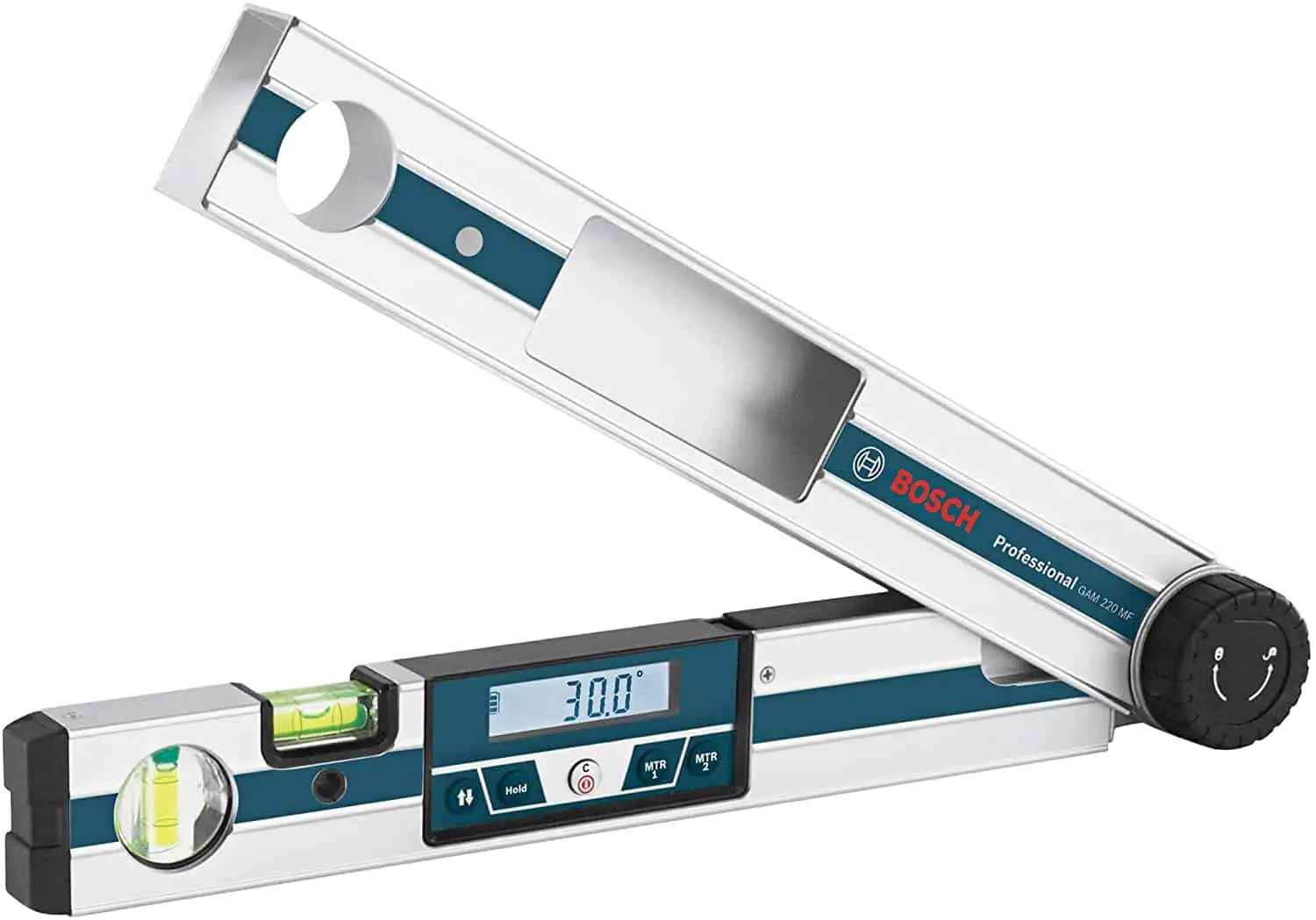 (view more images) |
| Best lightweight/compact digital angle finder: Wixey WR300 Type 2 | 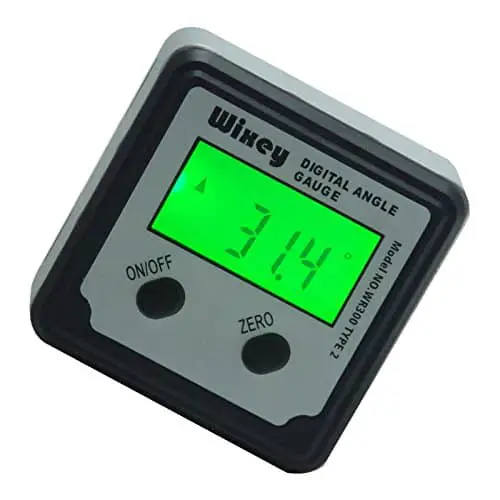 (view more images) |
| Best budget digital angle finder: General tools 822 | 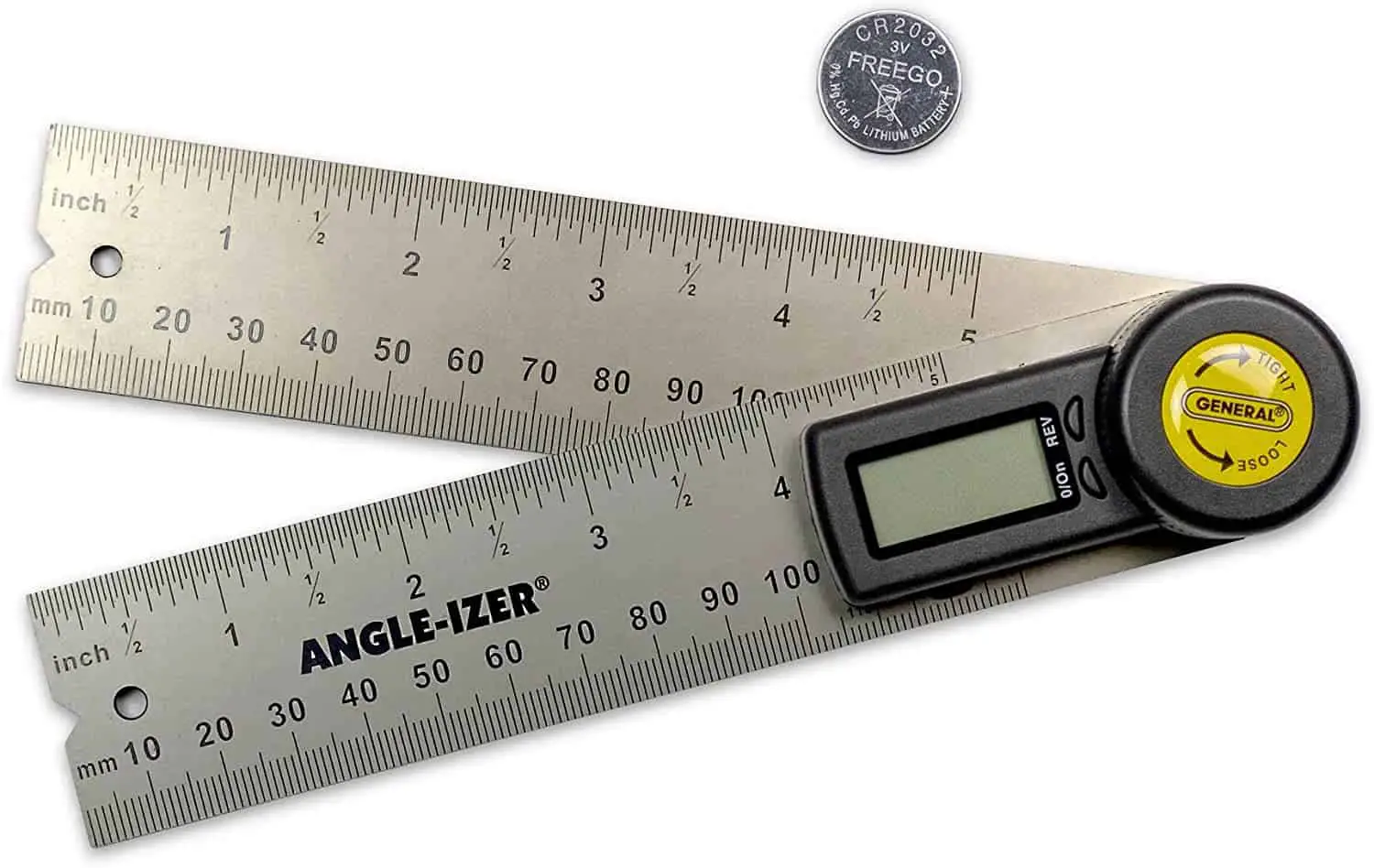 (view more images) |
| Best magnetic digital angle finder: Brown Line Metalworks BLDAG001 | 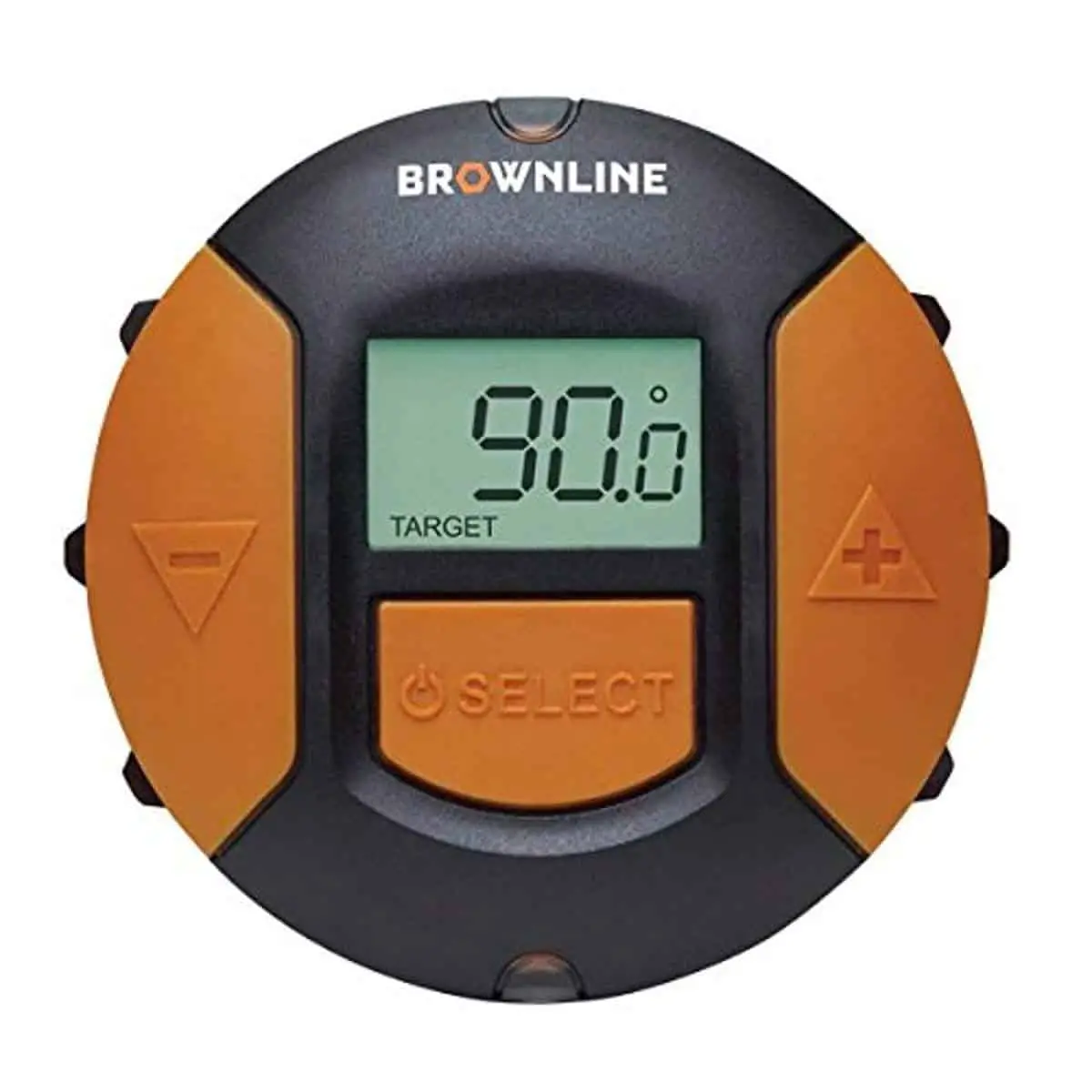 (view more images) |
| Most versatile digital angle finder: TickTockTools Magnetic Mini Level and Bevel Gauge | 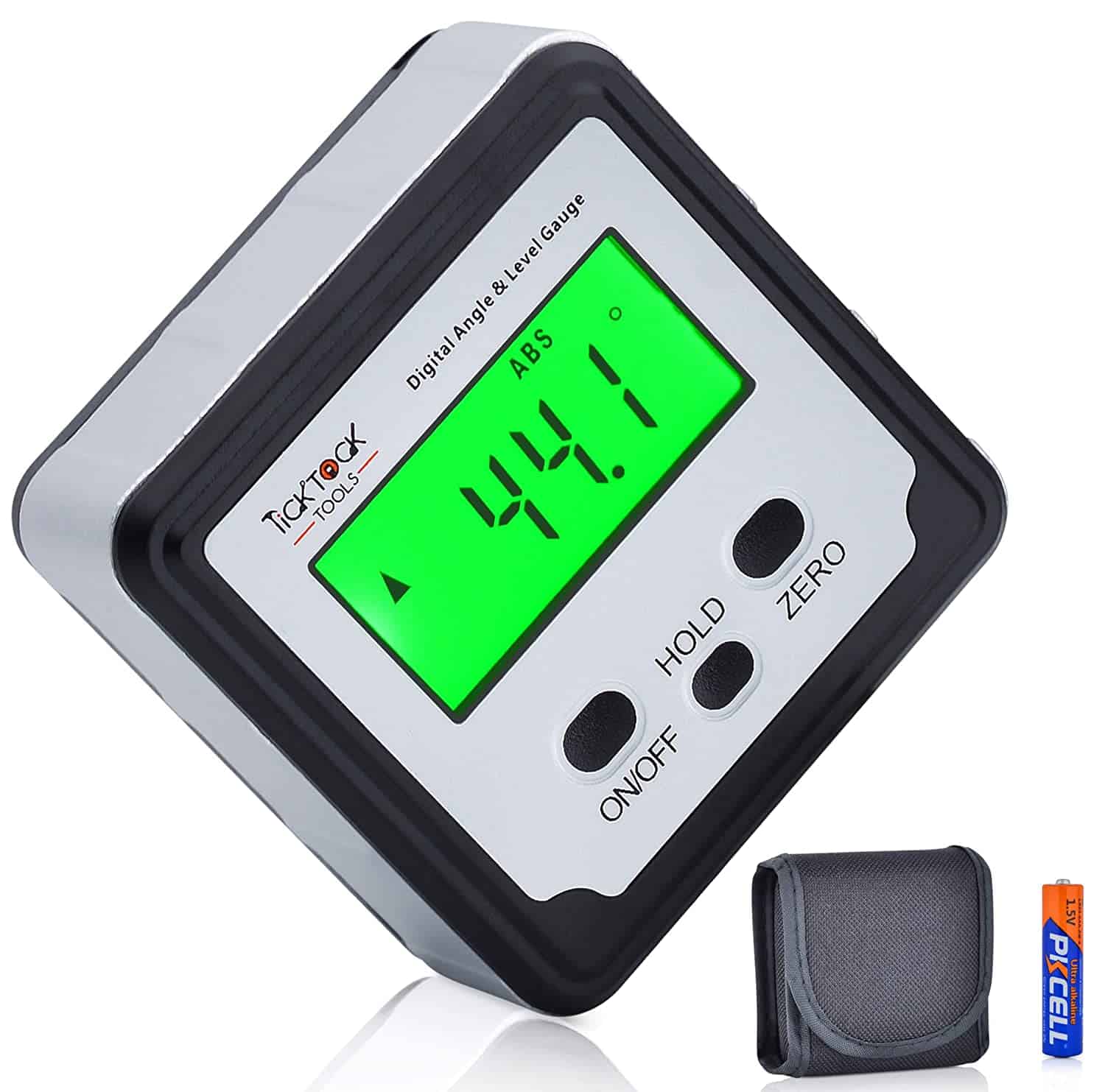 (view more images) |
| Best digital protractor with ruler: GemRed 82305 Stainless steel 7inch | 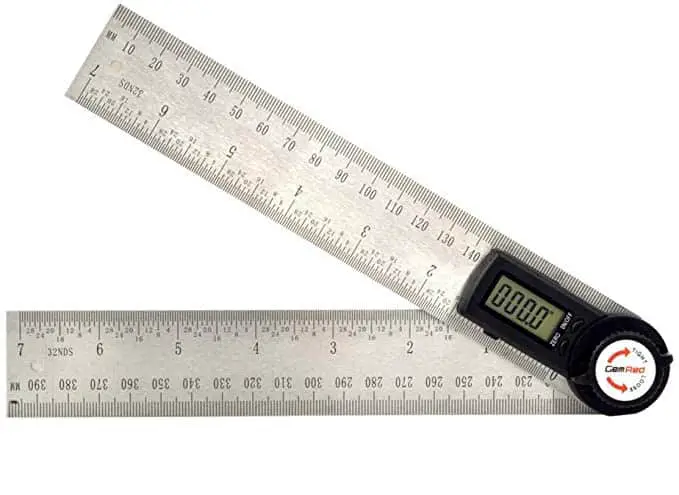 (view more images) |
| Best digital protractor with sliding bevel: General Tools T-Bevel Gauge & Protractor 828 | 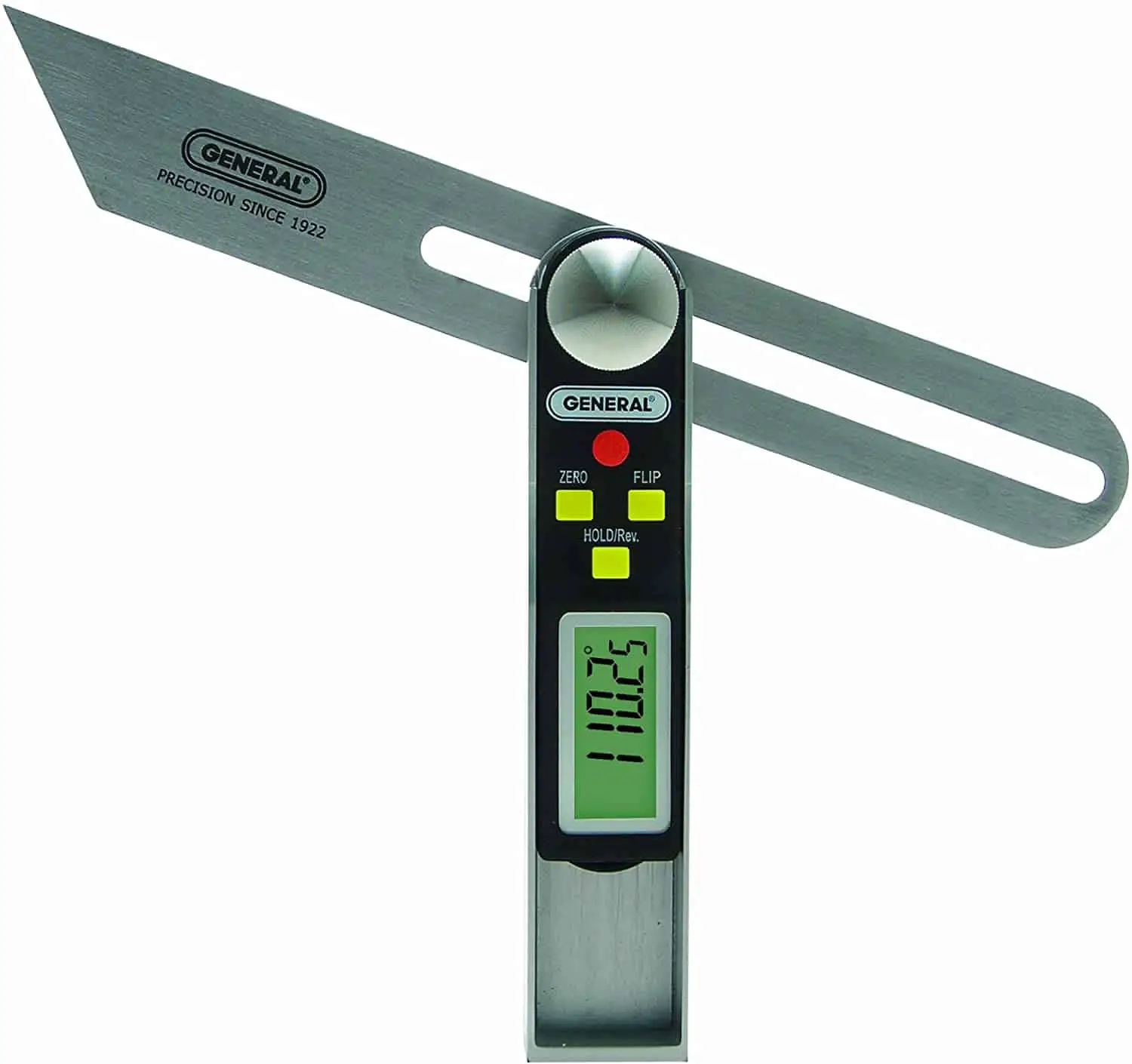 (view more images) |
| Best digital protractor with miter function: 12″ Wixey WR412 | 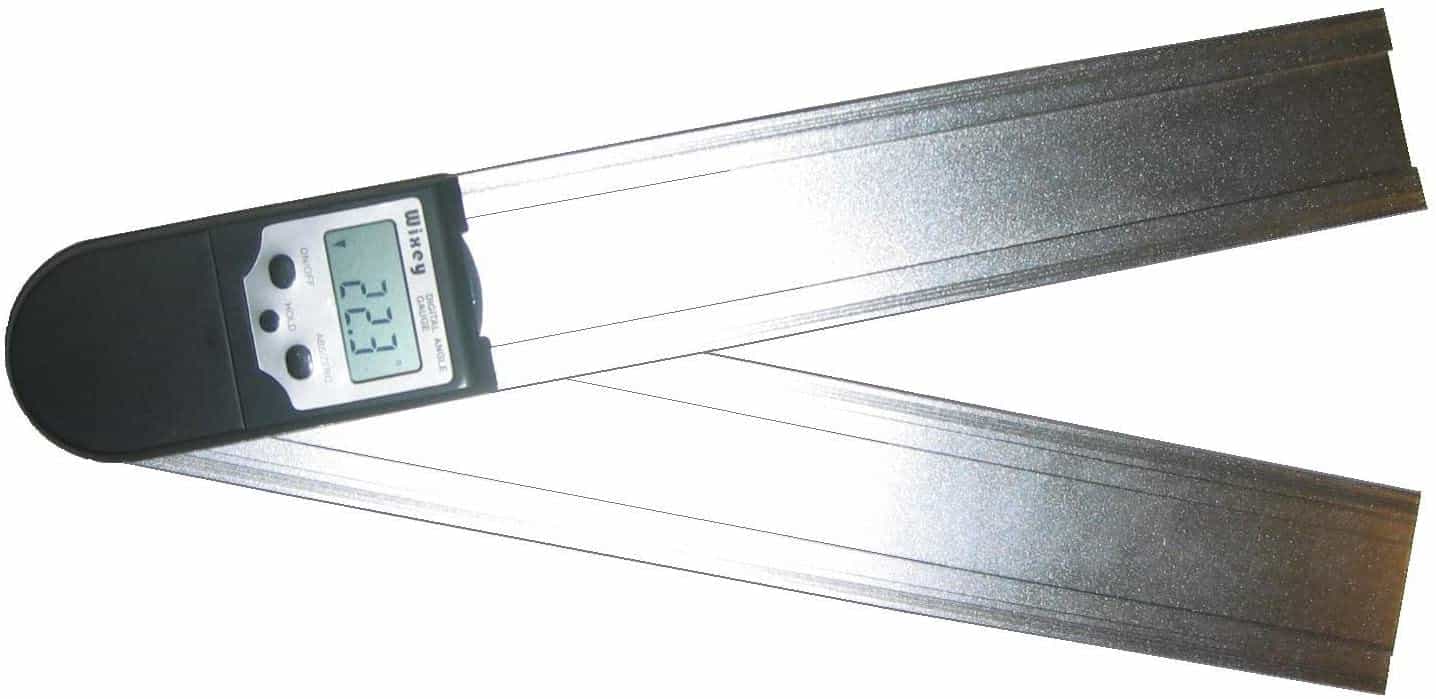 (view more images) |
In this post we'll cover:
- What is the difference between a digital angle finder and a digital protractor?
- Buyer’s guide: How to recognize the best digital angle finder/protractor
- Best digital angle finders on the market
- Best overall digital angle gauge: Klein Tools 935DAG
- Best digital angle finder/protractor for professionals: Bosch 4-in-1 GAM 220 MF
- Best lightweight/compact digital angle finder: Wixey WR300 Type 2
- Best budget digital angle finder: General tools 822
- Best magnetic digital angle finder: Brown Line Metalworks BLDAG001
- Most versatile digital angle finder: TickTockTools Magnetic Mini Level and Bevel Gauge
- Best digital protractor with ruler: GemRed 82305 Stainless steel 7inch
- Best digital protractor with sliding bevel: General Tools T-Bevel Gauge & Protractor 828
- Best digital protractor with miter function: 12″ Wixey WR412
- FAQs
- What is a digital angle finder?
- How accurate is a digital angle finder?
- What do you use a digital angle finder for?
- How do you use a digital angle finder?
- Why is a protractor called a protractor?
- Which side of protractor do you use?
- How do you reset a digital protractor?
- How do you zero a digital angle gauge?
- Conclusion
What is the difference between a digital angle finder and a digital protractor?
First off, let’s get the record straight. Are we looking at digital angle finders or protractors? Is there a difference? Is a protractor the same as an angle finder?
A digital angle finder and a digital protractor are both digital angle measuring devices. The terms are used interchangeably even by experts in the field.
They are both angle measuring devices and their functions are very similar. Here’s a deeper look at digital protractors and digital angle finders in detail.
What is a digital protractor?
All instruments that are used to measure plane angles are called protractors.
There are three main analog types including a simple semi-circular protractor which features angles from 0° to 180°.
Most of us will recognize these from our school days, as they are required for basic mathematics.
Before modern GPS and digital maps, ships captains used three-armed and course protractors to navigate through the oceans.
These days, we have digital protractors to help us measure angles.
Digital protractors can be a very helpful tool for woodworkers or people who want to do DIY work using wood.
A digital protractor is sometimes called a digital angle rule or a digital angle gauge. It can provide an accurate digital reading of all angles in a 360-degree range.
It has an LCD screen that shows the readings and often has a ‘hold’ button which allows the user to save the current angle while measuring a different area.
It consists of two rules, usually made from steel, that are joined with a movable hinge. Attached to the hinge is a digital device that reads the angle.
The angle at which the two rules are held from each other is recorded by the digital reader. Most have a locking function so the rules can be held at a specific angle.
It is used for measuring and drawing lines, for measuring angles and transferring angles.
What is a digital angle finder?
The digital angle finder is also sometimes referred to as a digital angle gauge.
Basically, an angle finder is a tool that helps you measure interior and exterior angles quickly and accurately.
An angle finder uses two hinged arms and an integrated protractor-like scale or digital device to read the angles, both inside and outside.
The digital angle finder has a device inside the pivot where the two arms meet. When the arms are spread, various angles are created.
The device recognizes the spreading and converts them to digital data. These readings are shown on the display.
A digital angle finder is often a multi-purpose tool that also functions as a protractor, inclinometer, level, and bevel gauge.
While mechanical angle finders can be tricky to use, digital ones offer close to 100% accuracy when it comes to angle measurement.
There is a device inside the pivot where the two arms meet. When the arms are spread, various angles are created and the device recognizes the spreading and converts them to digital data.
These readings are shown on the display.
There are also analog angle finders, I compare them to digital ones here
So, what’s the difference between an angle finder and a protractor?
The digital protractor functions mainly as a protractor, whereas the digital angle finder/gauge can sometimes have multiple functions.
The more advanced tools can be used as a protractor, an inclinometer, a level, and a bevel gauge.
So if you are looking for a more multifunctional tool, go for a digital angle finder. If you are looking for the most precise and dedicated angle measurement device, a digital protractor would suit your needs.
Buyer’s guide: How to recognize the best digital angle finder/protractor
When it comes to purchasing a digital angle finder, there are certain features that you should look at.
Display
Digital protractors can include LED, LCD, or digital displays. If you are looking for better accuracy then go for LED or LCD.
It is important that the readings are clearly visible and easy to read, both in dim lighting and bright sunlight.
A display with a clear view will make the task easier and less time will be required.
In some models, the LCD auto rotates, for easy viewing from all angles. Some models offer a reverse contrast display.
Some protractors include a backlight in the display. With a backlight protractor, it will make no difference if you are using the device during the day or the night.
With that, if you can get the automatic light-off feature there’ll be a lot less hassle with the batteries.
If the flip display is available then you won’t have to worry about placing the scale. This feature will rotate the reading according to the placing.
Material & built
Block type protractors require a robust framework which may be plastic or metal.
Aluminum alloy frames make the gadget lighter yet strong enough to go through rough use.
Accuracy
Most professionals seek an accuracy of +/- 0.1 degrees, and for household projects, an accuracy of +/- 0.3 degrees will do the job.
Linked to the accuracy level is the locking feature which allows the user to lock the readings at a certain angle to use later.
Weight
Digital protractors or angle finders made of aluminum will be lighter in weight than those made of stainless steel.
The weight of a digital protractor can be about 2.08 ounces to 15.8 ounces.
As you can imagine, with a weight of 15 ounces, it will be tough to carry it from one place to another.
So if you are looking for a more mobile device to take to job sites, check the weight.
Broad measurement range
Angle finders have different measurement ranges. It can be 0 to 90 degrees, 0 to 180 degrees, or up to 0 to 360 degrees.
So check if the pivot allows full rotation or not. Full rotation ensures 360 degrees measuring range.
The broader the measurement range, the greater the usefulness of the angle finder.
Battery life
Working efficiency generally depends on the life span of the battery.
An auto-shutdown feature will preserve the battery life of the device and are better in this case.
Also, be sure to check the number and size of batteries needed, and perhaps get a few spare.
Note that backlight and display size affects the service period of the battery.
Memory storage
A memory storage feature can save you time, especially when working on a large project.
It allows you to store and save your readings, instead of having to measure angles repeatedly.
Adjustable resistance
Two types of adjustable resistance are available that will keep the measuring angle at the exact position.
This resistance is created by a plastic or a metal knob at the joining point.
Metal joints create more durable resistance thus more accuracy, but you may need to sacrifice the cost of the device, whereas the plastic knobs are cheaper, but corrosion can occur.
Some protractors also include locking screws. It’s used to hold it tight at any angle.
This means that even with the movement of the tool, the locked value won’t be affected.
A reverse angle feature also helps in angle measurement.
Leg extension
Not all angle gauges can measure every required angle, it depends on the structure of the device.
If you need to determine angles in tight areas then the leg extension is your kind of feature.
This extension will help the device to determine those angles which are hard to reach.
Ruler
Some digital angle finders include a ruler system.
Rulers made of stainless steel make woodworking more precise than others.
The graduations should be engraved enough to last long. If you need the measurements of both length and angle on a regular basis, rulers are a better choice.
Zeroing at any point is easier with rulers as they have clear etched marks. It’s essential to measure relative inclination.
But rulers come with the hazard of cuts due to sharp edges.
Water-resistant
An angle gauge that has a water-resistant feature provides the flexibility of places or weather also.
For metal bodies, high temperatures can affect the measurement process.
Strong plastic frameworks support water resistivity more and hence during rough weather this tool can be used outside without reservation.
Best digital angle finders on the market
After researching the digital angle finders on the market, analyzing their various features, and noting the feedback from a wide range of users, I have come up with a list of products that I feel deserve to be highlighted.
Best overall digital angle gauge: Klein Tools 935DAG
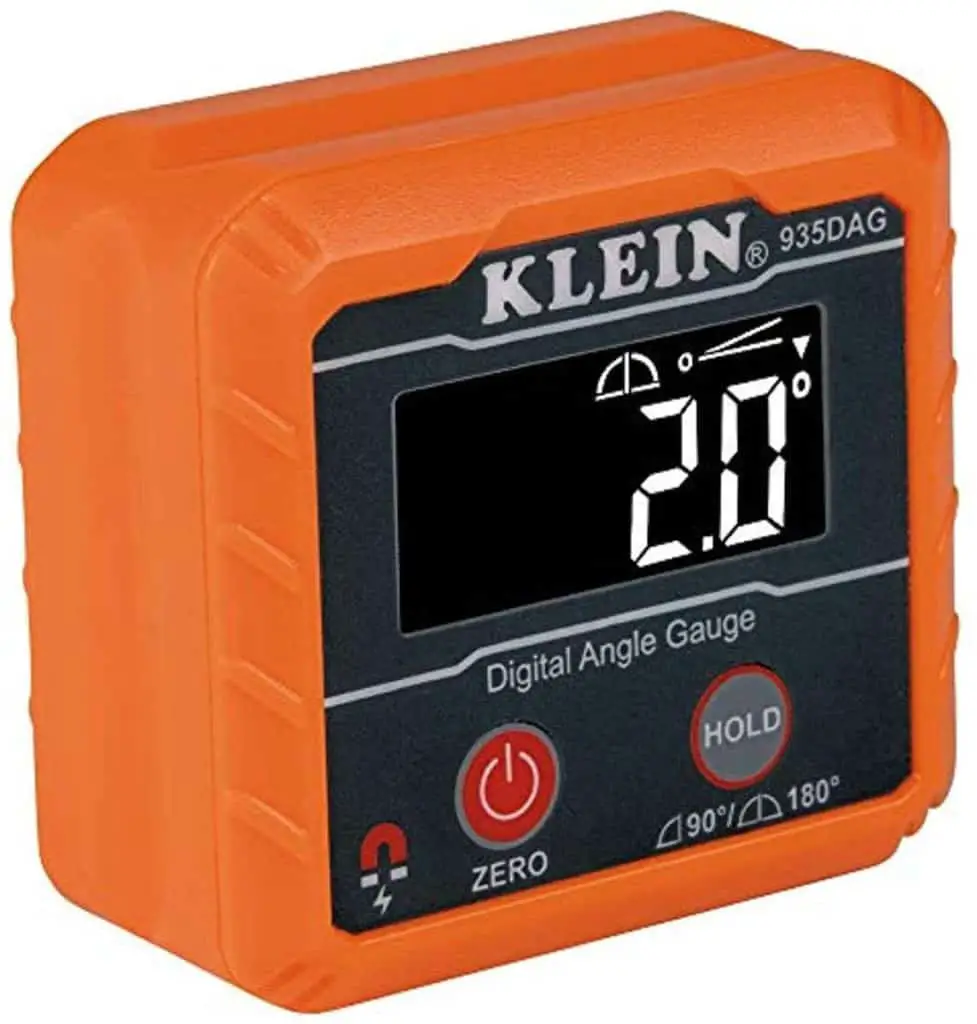
Outstanding value for money, versatility, and a wide range of applications make the Klein Tools Digital Electronic Level and Angle Gauge our favorite product overall.
This digital angle finder can measure or set angles, check relative angles with zero calibration feature, or it can be used as a digital level.
It features a measurement range of 0-90 degrees and 0-180 degrees which means it can be used for multiple applications, including carpentry, plumbing, installing electrical panels, and working on machinery.
It has strong magnets in its base and edges so that it sticks firmly to ducts, vents, saw-blades, pipes, and conduits.
You can see it in action here:
As you can see, the V-groove edges give optimal alignment on conduits and pipes for bending and alignment.
The high visibility reverse contrast display makes it easy to read even in dim lighting and the display auto-rotates when upside-down, for easy viewing.
Water and dust resistant. Soft carrying case and batteries included.
Features
- Display: High visibility reverse contrast display and auto-rotation, for easy reading.
- Accuracy: Accurate to ±0.1° from 0° to 1°, 89° to 91°, 179° to 180°; ±0.2° at all other angles
- Measurement range: 0-90 degrees and 0-180 degrees
- Battery life: Automatic shut off preserves battery life
- Strong magnets in the base and along edges to hold onto ducts, vents, and pipes
- Built-in level
- Comes in a soft carrying case and includes batteries
Best digital angle finder/protractor for professionals: Bosch 4-in-1 GAM 220 MF
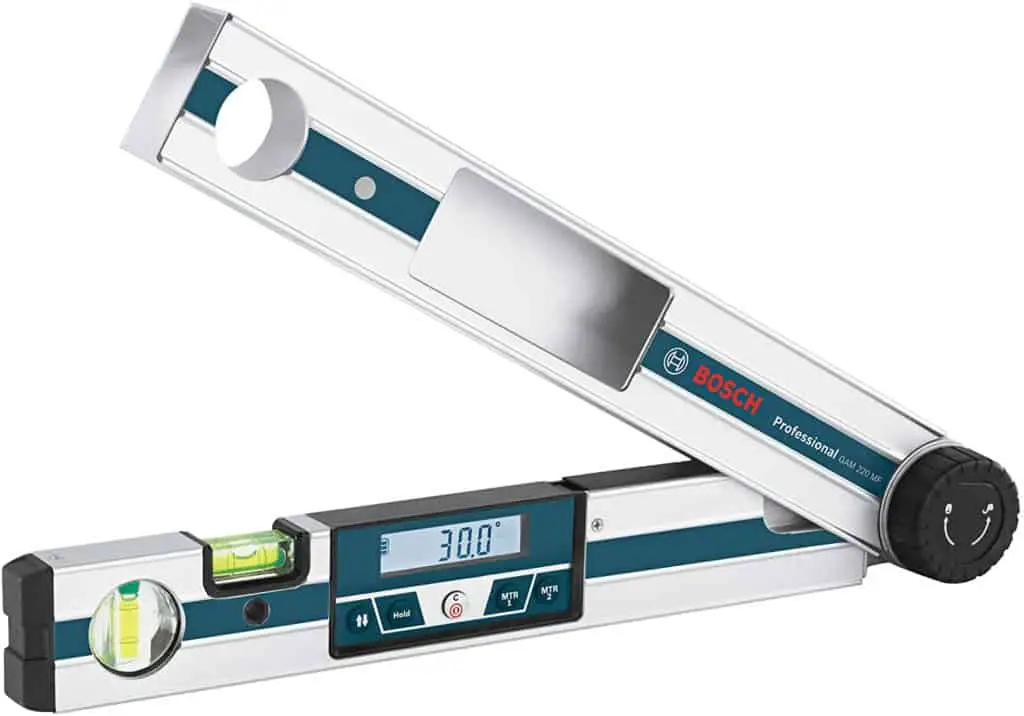
The Bosch GAM 220 MF Digital Angle Finder is four tools in one: an angle finder, a cut calculator, a protractor, and a level.
It can be aligned horizontally and vertically, and it has an accuracy of +/-0.1°.
These features make it the ideal choice for professional carpenters and contractors. However, it also means that this tool comes with a much heavier price tag.
The Bosch calculates simple miter angles, bevel angles, and compound bevel angles.
The simple miter cut calculation has an input range of 0-220°, and it includes a compound cut calculator. It has clearly labeled buttons for straightforward calculations.
This angle finder offers a very useful ‘memory’ feature which allows it to provide the same angle measurement on different areas of the job site.
The flip display is illuminated and rotating, making it easy to read in any environment.
It features a durable aluminum housing, and it is water and dust-resistant.
There is a built-in bubble level and two digital displays—one for the angle finder and the other for an included inclinometer.
Includes a hard storage case and batteries. It is a little too bulky for easy transport.
Features
- Display: Auto-rotating display is illuminated and easy to read
- Accuracy: accuracy of +/-0.1°
- Measurement range: The simple miter cut calculation has an input range of 0-220°
- Memory & Battery life: Memory feature for storing and saving readings
- Four tools in one: an angle finder, a cut calculator, a protractor and a level
- Built-in bubble level
- Includes a hard storage case and batteries.
Best lightweight/compact digital angle finder: Wixey WR300 Type 2

If much of your work is done in confined or difficult-to-reach spaces, then the Wixey WR300 Digital Angle Gauge is the tool to consider.
It is small and lightweight and can reach into spaces where no mechanical angle finder can operate.
The powerful magnets in the base adhere to cast-iron tables and steel blades so the tool can be used on bandsaws, drill passes, table saws, miter saws, and even scroll saws.
It comes with a 3-push button to power, hold and reset the measurement. Accuracy is around 0.2 degrees and it offers a range of 0-180 degrees.
The large, backlit display makes for easy viewing in dimly lit areas.
The device uses a single AAA battery with a battery life of about 6 months. There is an auto shut-off feature that kicks in after five minutes.
Comes with easy-to-follow instructions for operation and calibration.
Features
- Display: Large, backlit display
- Accuracy: Accuracy of around 0.2 degrees
- Measurement range: 0-180 degrees
- Battery life: Excellent battery life / Auto shutdown feature
- 3-push button to power, hold and reset measurements
Best budget digital angle finder: General tools 822
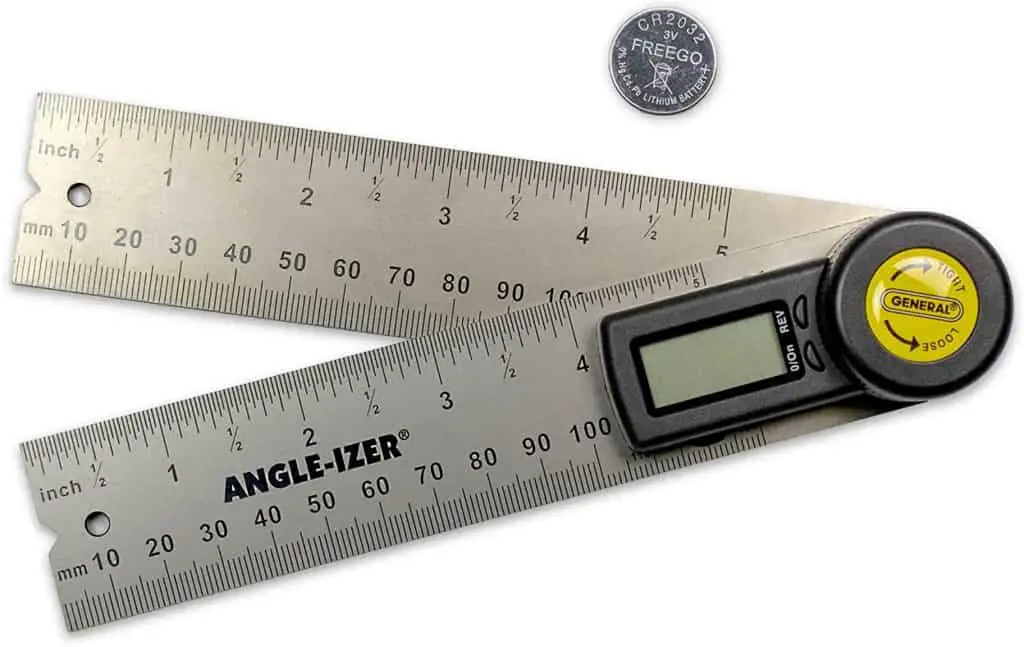
“Very accurate and functional, exceptional value for money”
This was the general feedback from a number of users of the General Tools 822 Digital Angle Finder.
This tool is a combination of the classic ruler and the digital angle finder with a locking capability, which makes it a truly versatile and accessible tool for any kind of woodwork.
At only five inches long, it is ideal for finding angles in tight spots and is particularly suited to framing and custom furniture making.
Made from stainless steel, it has a built-in reverse angle function. It is equipped with a large, easy-to-read display with an accuracy of 0.3 degrees and a full 360-degree range.
It can be re-zeroed at any angle, easily locked in place, switched to a reverse angle, and it turns off automatically after two minutes of inactivity.
Features
- Display: Large, easy to read display
- Accuracy: Accuracy of 0.3 degrees
- Measurement range: full rotation of 0-360 degrees
- Battery life: Auto-shutdown feature
- Built-in reverse angle function
- Angle lock feature
Best magnetic digital angle finder: Brown Line Metalworks BLDAG001
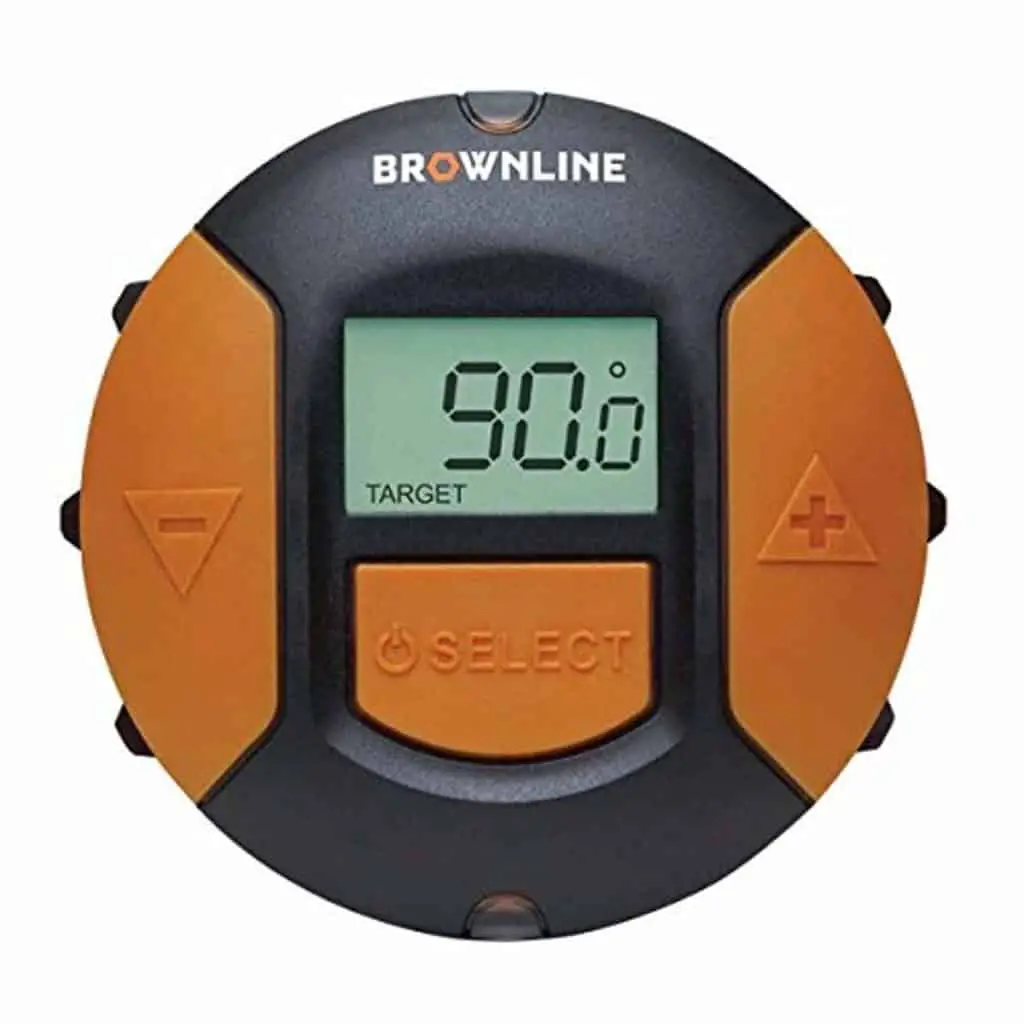
The features that set the Brown Line Metalworks BLDAG001 Digital Angle Gauge apart are its unique “audible feedback” capability, its outstanding magnetic ability, and its unusual rounded design.
It is a ratchet-mounted gauge that can be used for a multitude of applications, but its range of features also means it carries a heavier price tag.
It can be attached to any standard ratchet, wrench, or breaker bar to help determine the precise incline of a surface.
There is also a built-in feature that allows the user to keep track of angular rotation even when using a ratchet.
The V-shaped magnetic base locks tightly to any metallic handle, ensuring precision and accuracy of measurement. It offers +/-0. 2-degree accuracy.
The large buttons on the side allow the user to set the desired angle and when the device reaches that angle there is an audible alert as well as the backlit visual display which can show degrees, in/ft., mm/m, and percent slope.
It has an automatic shut-down feature, after two minutes of inactivity and a low battery indicator.
Features
- Display: Large, easy to read display showing degrees, in/ft., mm/m, and slope
- Accuracy: +/-0. 2-degree accuracy
- Measurement range: Up to 360°
- Battery life: Automatic shut-down feature
- Ratchet mounted- can be attached to any standard ratchet /wrench/breaker bar
- V-shaped magnetic base locks tightly to any metallic handle
- Audible alert when required angle is reached
Most versatile digital angle finder: TickTockTools Magnetic Mini Level and Bevel Gauge
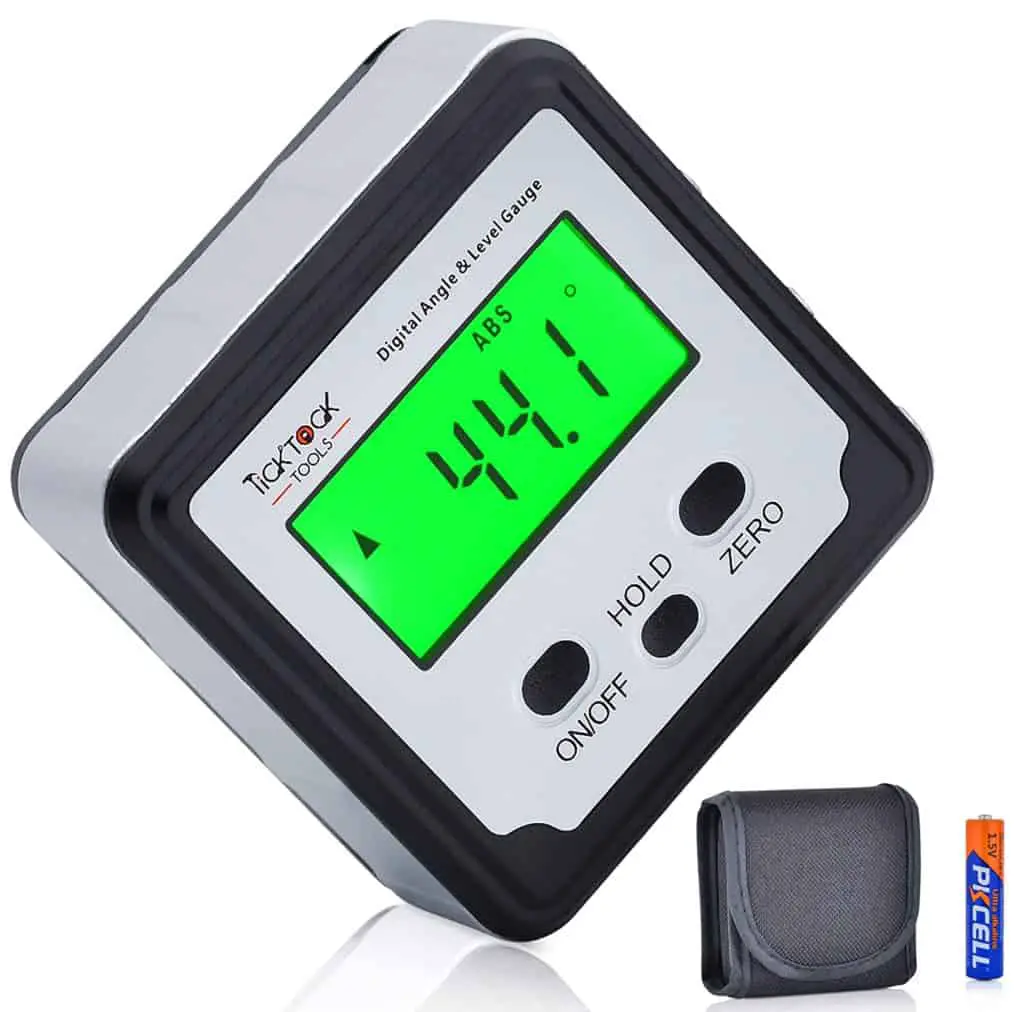
The Digital Angle Finder by TickTock Tools is several precise measuring tools all rolled into one easy-to-use device.
Its strong magnetic base holds on to any ferrous metal surface and can be used on table saw blades, miter saw blades, and band saw blades, for easy hands-free measurement.
This makes it suitable for many different applications including woodworking, construction, pipe bending, fabrication, automotive, installation, and leveling.
It offers easy and accurate measurement (0.1-degree accuracy) of absolute and relative angles, bevels, and slopes.
It offers a full rotation of 1-360 degrees and features a hold button to freeze measurements when the screen can’t be read in its current position.
The unit comes with one long-lasting AAA battery, a convenient carrying case for added protection, and a one-year warranty.
Features:
- Display: Large, easy to read, and highly accurate LCD display with backlight automatically inverts digits 180 degrees for overhead measurements
- Accuracy: 0.1-degree accuracy
- Measurement range: Full rotation of 360 degrees
- Battery life: 1 long-lasting AAA battery is included
- Magnetic base for easy hands-free measurement
- Convenient carrying case
Best digital protractor with ruler: GemRed 82305 Stainless steel 7inch

A combination of a ruler and protractor makes GemRed Protractor a user-friendly measuring tool.
Its digital readout is quick enough with an accuracy of ±0.3°. The display of the protractor has a resolution of 0.1 and doesn’t measure the slide downs and reverse angle.
GemRed protractor has a folded length of 220mm and an expanded length of 400mm and it can measure lengths up to 400mm.
Users can measure relatively as this protractor gives the flexibility of taking zero at any point. It also contains a locking screw if any angle needs to be held.
Because of its stainless steel body, it will give more durability but in this case, the user has to keep an eye on the temperature of the working place.
Hot temperatures will affect the metal and therefore the accuracy of the reading.
This protractor will give the best result while the temperature of the working place is 0-50 degrees C and humidity less than or equal to 85% RH.
It functions with a 3V lithium battery which is lightweight and eco-friendly.
As it’s made of stainless steel so edges will be very sharp. The user has to be conscious while using this ruler.
Features
- Display: Easy to read digital display that displays angle in 1-decimal
- Accuracy: accuracy of ±0.3 degree
- Measurement range: Full rotation of 360 degrees
- Battery life: Long-life CR2032 3V lithium battery (included)
- Stainless steel rulers with laser-etched scale
- Can also work as a T-bevel protractor
Best digital protractor with sliding bevel: General Tools T-Bevel Gauge & Protractor 828
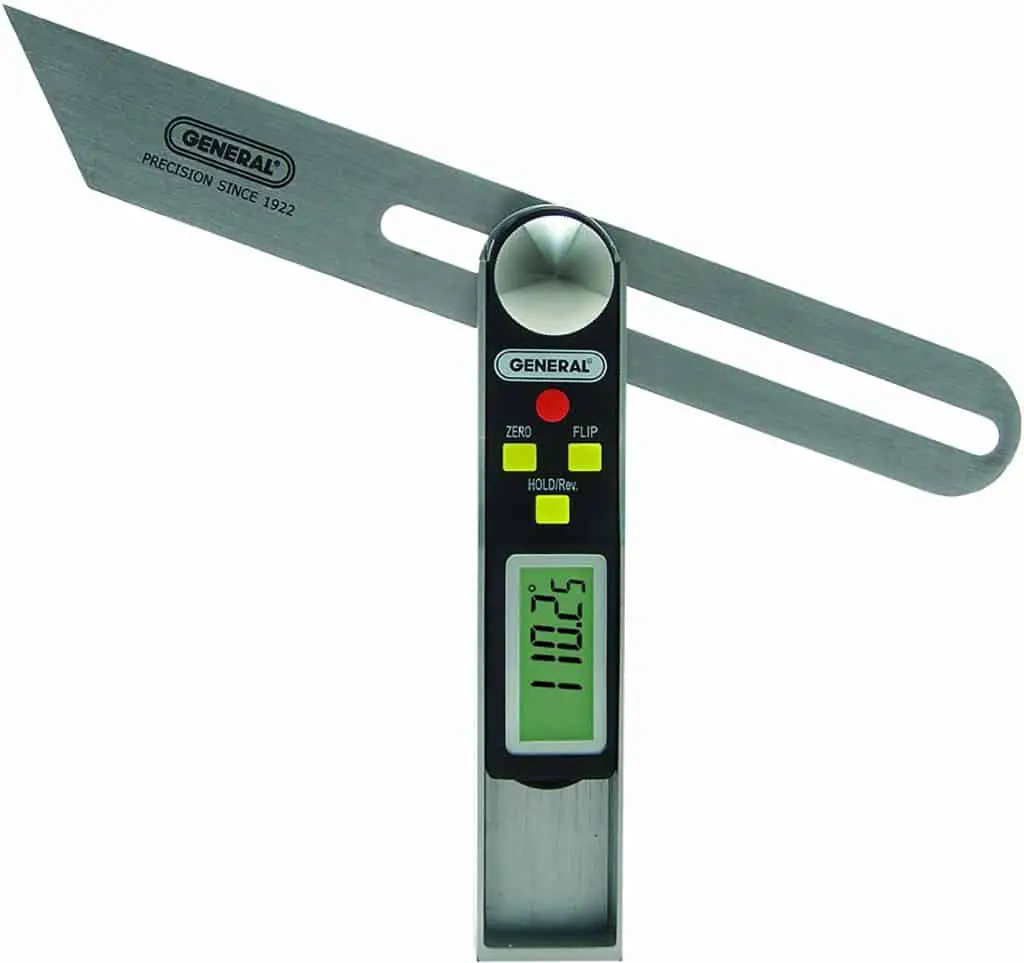
The General Tools 828 digital protractor is a combined package of T-bevel digital sliding gauge and protractor.
Its handle is impact resistant and takes measurements using a stainless steel blade.
ABS plastic body makes it lightweight. To be more precise, its overall dimensions are 5.3 x 1.6 x 1.6 inches and the weight of the tool is only 7.2 ounces which makes this easy to carry.
This protractor has a transitional display system which makes the measurement process easier. The digital gauge includes a reverse display and flip-display button.
The user can use both sides of the scale without any extra effort. The full LCD provides a large readout.
In the case of measuring angles, it will give 0.0001% accuracy which will make the cuts precise.
To operate the 828 protractor it requires 1 CR2 battery that offers a great battery life. The automatic shut-off feature extends the life span of the battery.
One downside of this tool might be that the protractor is too sensitive to get the exact reading. Also, the backlight isn’t included in the display so it’s hard to take the reading in dim light.
Features
- Display: Four large control buttons provide five functions, including power on/off, reading hold, read reverse angle, flip display, and clear readout
- Accuracy: accuracy of ±0.3 degree
- Measurement range: Full rotation of 360 degrees
- Battery life: 1 CR2032 lithium-ion battery is included
- Commercial-grade digital sliding T-bevel and digital protractor
- Impact-resistant ABS handle with a 360-degree stainless steel blade
Best digital protractor with miter function: 12″ Wixey WR412
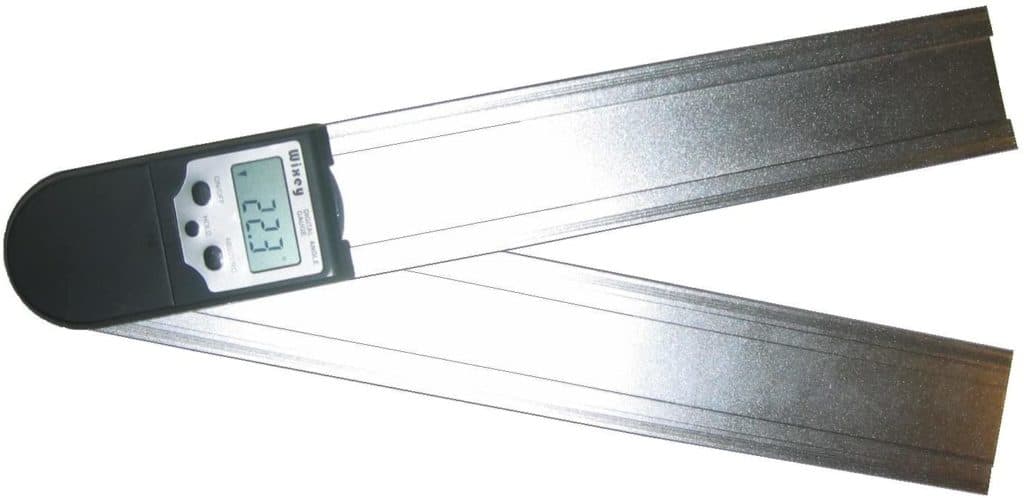
This Wixey digital protractor is a great device to measure the angle in any plane and includes a “Miter Set” feature that instantly calculates the proper angle for cutting perfect miters.
This 13 x 2 x 0.9 inches digital protractor is also a great tool for trim work and crown molding.
All blade edges include strong magnets which will ensure the stability of the tool on any iron surface.
Blades can be tightened for measurement purposes. The longer legs increase its working flexibility.
The main manufacturing material is stainless steel so its blades are quite sharp and have a rigid body. Etch marks are clear and it’s easy to take the reading with this tool.
The product is matte black painted making it look better and more attractive.
Its total weight of 15.2 ounces is quite heavy, which can present some problems while carrying it around.
Features
- Display: Simple easy-to-read display
- Accuracy: +/- 0.1-degree accuracy and repeatability
- Measurement range: range of +/-180-Degrees
- Battery life: A single Lithium metal battery is required to supply power and battery life is about 4500 hours
- The heavy-duty aluminum blades include embedded magnets on all edges
- The simple functions include an ON/OFF button and a ZERO button
FAQs
What is a digital angle finder?
A digital angle finder is a multi-functional tool for many measuring applications.
Easy to operate, the base unit carries the electronics giving a very clear detailed LCD display as well as a pair of leveling vials and a pivoting measuring arm.
How accurate is a digital angle finder?
Most angle finders are accurate to within 0.1° (one-tenth of a degree). That is sufficiently accurate for any woodworking task.
What do you use a digital angle finder for?
This tool can have various applications, depending on the types of readings it can perform.
The most common use, however, is the measurement of angles – whether you’re checking the bevel of a saw, the degree of incline, or the position of certain materials (such as metal pipes).
Gauges with more applications include inch/feet or millimeter/meter readings.
How do you use a digital angle finder?
When you first acquire the tool, make sure that you calibrate it (you can find out how in the introduction segment of this article) first so that it will give accurate readings.
Then, you use it by attaching it to the surface that you need it to read – if you’re doing a comparison, you don’t have to press any buttons, but if you need a beveled surface to be the reference, then you can press the Zero button once you have the tool in position.
To hold a reading from one spot to another, press the Hold button (if the model has this function), and to release it, press the same button again.
Once you’re done using it, you can turn off the tool, but most come with an automatic shut-down so that the battery won’t drain out.
Read more: How to Measure an Inside Corner with a General Angle Finder
Why is a protractor called a protractor?
By the seventeenth century, protractors were standard tools for navigation at sea by sailors.
These protractors were called three arm protractors because they had a circular scale and three arms.
Two arms were rotatable, and one central arm was fixed so the protractor could set any angle relative to the center arm.
Which side of protractor do you use?
If the angle opens to the right side of the protractor, use the inner scale. If the angle opens to the left of the protractor, use the outer scale.
How do you reset a digital protractor?
The most common way in which you can reset a digital gauge is by holding the on/off button for a few seconds, releasing it, waiting for approximately 10 seconds, and then holding the same button again until the unit turns on.
Other models might have the Hold button as the reset one, and since variations like this exist, it would be better for you to consult the instruction manual.
How do you zero a digital angle gauge?
You do so by positioning the gauge on the surface you need to measure and pressing the zero button once to get the reading to show 0.0 degrees.
The purpose of this action is to allow you to have surfaces that aren’t straight and flat as a reference, as opposed to only reading perfectly level ones.
Conclusion
With this information in hand, you are now in a better position to choose the best digital angle finder for your needs and your budget.
Whether you need a highly accurate digital angle finder for professional use, or you need a budget-friendly digital angle finder for home hobbies, there are ideal options available for you.
When to use which? I explain the differences between a T-bevel and a digital angle finder here
I'm Joost Nusselder, the founder of Tools Doctor, content marketer, and dad. I love trying out new equipment, and together with my team I've been creating in-depth blog articles since 2016 to help loyal readers with tools & crafting tips.
